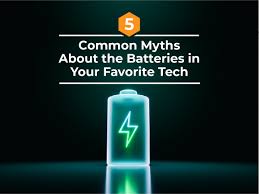Introduction:
7 Tech Battery Myths Busted to Save Power
Myth 1: Closing Apps Saves Battery
Swiping away apps feels like tidying up a cluttered room, but does it really save battery? Spoiler: it doesn’t! Modern smartphones, whether running iOS or Android, are built to manage background apps efficiently. When you “close” an app, it’s typically frozen, using almost no power.
Constantly closing and reopening apps forces your phone to reload them, which burns more battery than letting them chill in the background. This is one of the biggest tech battery myths busted!
Why it’s a tech battery myths: Apple explains that background apps are optimized to use minimal resources, and closing them can increase power consumption.
What to do instead:
- Leave apps in the background unless they’re acting up.
- Go to Settings > Battery to spot apps draining power unnecessarily.
- Keep apps updated for better efficiency (How to Update Apps Safely).
- Restart your phone weekly to clear any rogue processes.
Example: Jake, a gamer, used to swipe away all apps after playing PUBG. After letting apps stay, he saved 12% battery daily, enough for an extra hour of streaming.
Pro tip: If an app is hogging battery, try uninstalling and reinstalling it to fix glitches, or check for updates in your app store.
Read more: 10 Hidden Android Settings That Will Blow Your Mind
Myth 2: Always Charge to 100%
Charging your phone to 100% feels like topping off a water bottle before a hike—necessary, right? Wrong! Lithium-ion batteries, the kind in every smartphone, prefer partial charges. Pushing to 100% every time stresses the battery, shortening its lifespan over months or years. This is a classic tech battery myths busted moment!
Why it’s a myth: Batteries have about 500 full charge cycles (0–100%). Partial charges (e.g., 20–80%) count as fractions of a cycle, preserving battery health longer.
What to do instead:
- Aim to keep your battery between 20% and 80% for optimal health.
- Enable “Optimized Battery Charging” on iPhones or “Adaptive Charging” on Androids to pause charging at 80%.
- Unplug after charging to avoid trickle charging, which can wear the battery.
- Use a smart plug to schedule charging if you’re forgetful.
Example: Lisa, a busy mom, started charging her iPhone to 80% and unplugging it. After 18 months, her battery health was still at 96%, compared to her old phone’s 78%.
Pro tip: If you need a full charge for a long day, do it occasionally, not daily, to minimize battery wear and tear.

Myth 3: Overnight Charging Kills Battery
Leaving your phone plugged in all night sounds like a battery assassin, doesn’t it? But modern smartphones are smarter than that! They stop charging at 100% and switch to drawing power directly from the charger, preventing overcharging. This tech battery myths busted revelation can ease your nighttime charging worries.
Why it’s a myth: Smart charging tech in devices like Samsung Galaxy and iPhones ensures batteries aren’t overcharged, even overnight.
What to do instead:
- Use a high-quality, certified charger to ensure stable voltage delivery.
- Enable iPhone’s “Optimized Battery Charging” or Android’s equivalent to pause at 80%.
- Avoid cheap, uncertified cables that may overheat (Best Charging Cables for 2025).
- Check your battery health periodically in Settings to monitor performance.
Example: Tom, a retiree, charged his Android phone overnight with a certified charger for two years. His battery health stayed at 91%, debunking the myth.
Pro tip: If you’re paranoid about overnight charging, charge during the evening and unplug once full to give your battery a rest.
Myth 4: Low-Power Mode Ruins Performance
Low-Power Mode feels like putting your phone on life support—everything slows to a crawl, right? Not really! It reduces background tasks, dims the screen, and throttles non-essential processes, but your core apps like texting or calling work perfectly. This is another tech battery myths busted to set straight.
Why it’s a myth: Low-Power Mode is engineered to save battery without crippling your phone’s usability, making it a lifesaver when you’re low on juice.
What to do instead:
- Turn on Low-Power Mode when your battery hits 20% (Settings > Battery).
- Use it during long outings, like road trips or festivals, without a charger.
- Disable it for heavy tasks like gaming or streaming HD videos.
- Combine with other battery-saving tricks for maximum effect.
Example: Emma, a music festival fan, used Low-Power Mode during a weekend event. Her iPhone lasted 14 hours, letting her capture every moment.
Pro tip: If you notice lag in Low-Power Mode, toggle it off temporarily for demanding apps, then turn it back on.
Myth 5: Wi-Fi Drains More Than Mobile Data
Ever heard the rumor that Wi-Fi chews through your battery faster than mobile data? That’s a big nope! Wi-Fi connections are generally more stable and use less power than cellular signals, which require your phone to constantly hunt for cell towers. Let’s add this to our tech battery myths busted list!
Why it’s a myth: Android Authority tests confirm Wi-Fi is more battery-efficient than mobile data in most cases.
What to do instead:
- Connect to Wi-Fi at home, work, or public hotspots to save battery.
- Turn off Wi-Fi scanning in Settings when you’re on the move.
- Disable mobile data when on Wi-Fi to prevent signal switching (How to Save Mobile Data).
- Forget unused Wi-Fi networks to avoid automatic connections.
Example: Mike, a freelancer, switched to Wi-Fi at coffee shops and saved 15% battery daily, enough for extra Zoom calls with clients.
Pro tip(tech battery myths): In areas with weak Wi-Fi, switch to mobile data to avoid battery drain from constant reconnect attempts.
Myth 6: Screen Brightness Barely Matters
Think maxing out your screen brightness doesn’t dent your battery? Think again! Your phone’s display is the biggest battery hog, and cranking brightness to 100% can drain it in hours, especially on high-resolution AMOLED or 4K screens. This is a major tech battery myths busted moment!
Why it’s a tech battery myth: OLED and LCD screens consume significant power at high brightness, with displays accounting for up to 50% of battery drain.
What to do instead:
- Enable Auto-Brightness in Settings to adjust to ambient light.
- Manually lower brightness in dim settings, like indoors or at night.
- Use dark mode on OLED screens, as black pixels use less power.
- Shorten screen timeout to 30 seconds (Settings > Display).
Example: Sarah, a student, enabled Auto-Brightness and dark mode on her Samsung phone, gaining 3 extra hours of battery for late-night studying.
Pro tip(tech battery myths): Avoid using your phone in direct sunlight without Auto-Brightness, as it forces the screen to max out, draining battery fast.

Myth 7: Third-Party Chargers Are Unsafe
Third-party chargers are often demonized as battery killers, but that’s not the whole story. Certified chargers from trusted brands like Anker, Belkin, or RavPower are safe and won’t harm your battery if they meet industry standards. Let’s wrap up our tech battery myths busted with this one!
Why it’s a myth: Chargers with certifications like USB-IF (for Android) or MFi (for iPhones) deliver stable, safe power, matching original chargers.
What to do instead:
- Buy chargers with certifications (e.g., MFi for iPhones, USB-IF for Android).
- Avoid dollar-store cables that may overheat or deliver unstable power.
- Check reviews before purchasing (Top Chargers for 2025).
- Inspect cables regularly for fraying or damage.
Example: Alex, a tech enthusiast, used a certified Anker charger for his Google Pixel. After 18 months, his battery health was still at 93%.
Pro tip(tech battery myths): Look for certification logos on the charger or packaging, and stick to reputable retailers to avoid fakes.
Bonus Battery-Saving Tips
Now that we’ve tackled these tech battery myths busted, let’s supercharge your battery life with extra tips. These are like the secret sauce to keep your phone powered all day!
| Tip | Why It Works | Estimated Battery Savings |
|---|---|---|
| Disable Background App Refresh | Stops apps from updating in the background, saving power. | 5–10% |
| Turn Off Push Notifications | Reduces constant app pings that wake your phone. | 3–7% |
| Use Airplane Mode in Low Signal Areas | Prevents your phone from searching for weak signals. | 10–15% |
| Limit Location Services | Stops apps from tracking your location in the background. | 5–8% |
| Disable Haptic Feedback | Reduces power used for vibrations on touch. | 2–5% |
Pro Tip (tech battery myths): Combine these with our myth-busting tips for up to 35% more battery life. For more hacks, check out our guide on Extending Battery Life or Speeding Up Your Phone.
FAQs on Tech Battery Myths
Does closing apps save battery life (tech battery myths)?
No, closing apps can use more battery as apps restart. Modern phones freeze background apps, using minimal power. Let them stay unless they’re misbehaving.
Does overnight charging harm my phone’s battery?
No, modern phones stop charging at 100% and use charger power. Use certified chargers to avoid voltage issues and ensure battery safety.
Is Low-Power Mode bad for my phone (tech battery myths)?
No, Low-Power Mode reduces background tasks and brightness but doesn’t harm your phone. It’s ideal for extending battery life when low.
Does Wi-Fi use more battery than mobile data?
No, Wi-Fi typically uses less battery than mobile data, as it’s more stable. Connect to Wi-Fi when possible to save power.
Are third-party chargers safe for my battery?
Yes, if certified (e.g., MFi or USB-IF). Avoid cheap, uncertified chargers that may overheat or deliver unstable power, harming your battery.
Conclusion
Busting these tech battery myths busted is like clearing out a junk drawer—suddenly, everything makes sense! By ditching bad habits like closing apps, overcharging, or fearing Wi-Fi, you can extend your smartphone’s battery life and enjoy your device stress-free. Whether you’re a teen glued to Snapchat, a professional on endless emails, or a senior mastering video calls, these tech battery myths busted tips work for all.
Try them today: enable Auto-Brightness, use certified chargers, and embrace Low-Power Mode. Your phone will thank you with hours of extra juice! Got a battery-saving trick we missed? Drop it in the comments below! For more tech hacks, explore our guides on extending battery life, speeding up your phone, securing your device, or saving mobile data.


В этом интересном тексте собраны обширные сведения, которые помогут вам понять различные аспекты обсуждаемой темы. Мы разбираем детали и факты, делая акцент на важности каждого элемента. Не упустите возможность расширить свои знания и взглянуть на мир по-новому!
Подробнее – https://vyvod-iz-zapoya-1.ru/